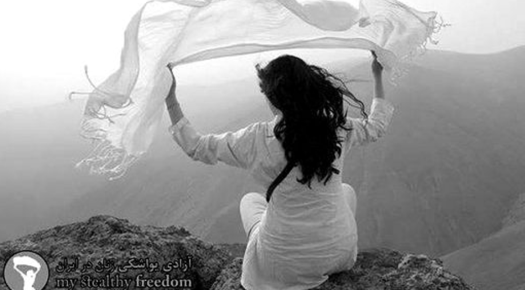
An Iranian woman climbed utility box and removed her head scarf, tied it to a stick and waved it for all to see. Later that day several other women, a total of six, according to social media accounts, made the same symbolic gesture: taking off their head scarves in public and waving them on a stick, emulating a young woman who climbed on the same sort of utility box on Dec. 27 and was subsequently arrested. Activists say she has since been released, but she still has not resurfaced in public.
The Islamic head scarf, or hijab, is seen by Iranian ideologues as a pillar of the Islamic Republic of Iran. Wearing of headscarf and chador was one of main symbols of the 1979 Iranian or Islamic revolution, along with the resurgence and wearing of other traditional Iranian dresses. Iran's young people have been calling for a change in the law regarding dress code. As the 28-year-old woman said, “I took my scarf off because I’m tired of our government telling me what to do with my body.”
Ms. Alinejad, an exiled Iranian journalist and activist living in the United States, has reached out to Iranian women on Persian-language satellite television and through social media, and via a website she runs called My Stealthy Freedom. On the website, women post images of themselves without head scarves, demanding an end to the compulsory head scarf law. He has called on women in Iran to observe “White Wednesdays,” wearing white and removing their veils and waving them overhead on sticks to protest the compulsory hijab and other religious restrictions imposed on women.
New York Times reports that hard-liners accuse foreign enemies, specifically the Americans, of supporting this situation in the country. “These protests are done by instigators, saboteurs and vandalists and anarchists,” said one critic, Kazem Anbarlooie, the editor in chief of the hard-line newspaper Resalat. “Recently our enemies were communists and liberals, now Americans are provoking masochists against us.”
A three-year-old report was released and showed that nearly half of Iranians wanted an end to the requirement that women cover their heads in public. The report found that 49.8 percent of Iranians, both women and men, consider the Islamic veil a private matter and think the government should have no say in it. The study is from 2014, and publishing it now suggests that it is a politically calculated decision by the president Hassan Rouhani because he saw this as a moment to challenge the hard-liners, who hold ultimate power. The obligation of the veil is an important issue for symbolic reasons and it represents a stronghold of hard-liners. If the rule of head covering is changed, hard-liners will lose some of their power.
Soheila Jolodarzadeh, a female member of the Iranian parliament, said the protests were the result of longstanding restrictions. “They’re happening because of our wrong approach,” she said, according to the semi-official Ilna news agency. “We imposed restrictions on women and put them under unnecessary restrains. This is why ... girls of Enghelab Street are putting their headscarves on a stick.”
Recent unrest in Iran began as protests against bad economic conditions but they have quickly turned into something much bigger. Iranian citizens demonstrated against the Islamist controlled government as a whole. These were the largest wave of demonstrations since nationwide pro-reform unrest in 2009. Nearly 5,000 protesters were detained and 25 were killed — some of them, families of the victims say, at the hands of their jailers.
The Trump administration commended the anti-hijab demonstrators on Friday. “People should be free to choose the clothes they wear, and practice their faith as they desire,” State Department spokeswoman Heather Nauert said.
Photo Credits: My Stealthy Freedom
